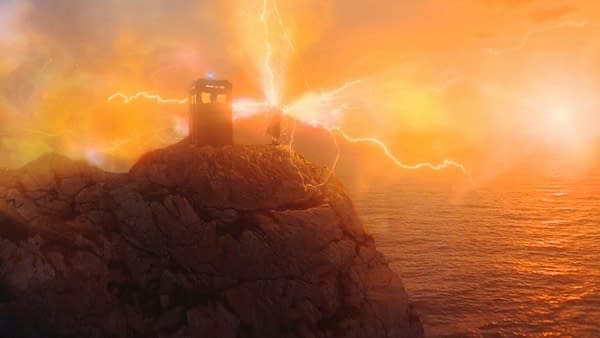Posted in: BBC, Doctor Who, TV | Tagged: bbc, chris chibnall, david tennant, doctor who, jodie whittaker, russell t davies, steven moffat
Doctor Who: A Half-Century of Regenerations Get More Epic & Mythical
Over 50 years of regenerations made Doctor Who not only a show that could run forever but also turned the Doctor increasingly Christ-like.
Doctor Who is the longest-running Science Fiction TV series next to Star Trek and one of the longest-running television series in the world. The reason it's managed to become that is due to the hero being able to regenerate into a new actor. Think about it. By making the Doctor immortal, the BBC has given the show the chance to be immortal. The BBC releasing a compilation video of all the Doctor's regenerations gives us a lot of food for thought.

How Regeneration Made Doctor Who Unique
It's funny when you find out that the idea of regeneration was thought up to replace William Hartnell when his failing health was making it untenable to keep him on Doctor Who, and the show was so popular the BBC didn't want to cancel it. That was a genius move that turned the show from a one-off into the one show on the planet that could go on forever as the same show but with different actors. Alas, the scene where Hartnell regenerated into Patrick Troughton has been erased along with the latter's entire first story, "The Power of the Daleks," and only a tiny clip was left. It was a regeneration that brought in the Doctor's people, who were initially unnamed, then they became Gallifrey, and a whole flood of lore about them came up, mostly made up as the writers went along over the decades but became an ongoing obsession with hardcore fans. It's a sign of fan engagement when they become fixated on a show's lore and mythology to the point of generating the worst ideas for the show, now often in the form of "leaks" that are convoluted and would have tanked the show if any of them became true. As the great cultural historian John Higgs said in a recent podcast, "Every 'leak' is really an essay by that fan about what they think the show should be.
How Regeneration Fueled Fan Obsession with Gallifrey Lore
We've had fifteen canonical Doctors in the show already, seventeen if you count the War Doctor, played by John Hurt, and the mysterious Fugitive Doctor, played by Jo Martin. The latter doesn't have a regeneration to or from whichever Doctor she came from or would change to because her creator Chris Chibnall has left her place in canon mysterious, knowing fans would speculate and obsess endlessly for years. Hell, for the rest of history, as long as there are any fans left. Some believe she existed before the First Doctor (William Hartnell), and others believe she was between the Second Doctor (Patrick Troughton) and the Third (Jon Pertwee). There's also the Valeyard, an evil incarnation of the Doctor who occurred between two of their regenerations, introduced in the Sixth Doctor's (Colin Baker) disastrous second series in a hastily slapped-together trial framing arc for that season. Fans keep obsessively speculating about when the Valeyard would return, but he was not only a terrible, contrived idea but also redundant – we already have The Master if we ever wanted an evil version of the Doctor. That makes the Valeyard redundant unless a showrunner finds a good reason to bring him back.

Regeneration has Made the Doctor a Christ-Figure
Regeneration in Doctor Who became more mythical and epic, starting with the 2005 revival. It was Russell T. Davies who gave the dying Doctor a golden glow and explosion of energy that can blow up the TARDIS when they regenerate. Steven Moffat and Chris Chibnall have continued that new tradition. It's kind of Freudian in how regeneration looks like a massive orgasm. When the Doctor stretches out their arms at regeneration, they also look Christ-like, a figure of resurrection on the cross, which is interesting considering Davies and Moffat are atheists. Granted, they are Church of England atheists who still reference biblical motifs with The Doctor, but that's the magpie nature of the show. As John Higgs said, the TARDIS is also a take-off of the wardrobe from C.S. Lewis's The Lion, the Witch and the Wardrobe, a box that serves as a portal to a new world, and Lewis' children's book has always been an overt Christian analogy. The Doctor is a combination of archetypes: the wizard, the mad professor, the trickster, the children's secret friend, and the storyteller… so why not the savior? That's always been the character's central appeal.














